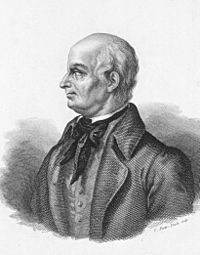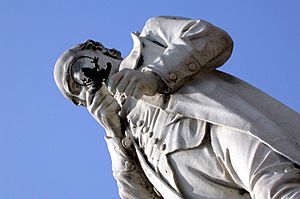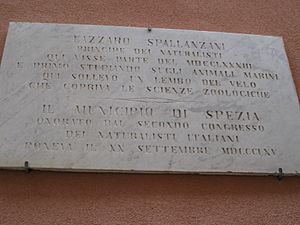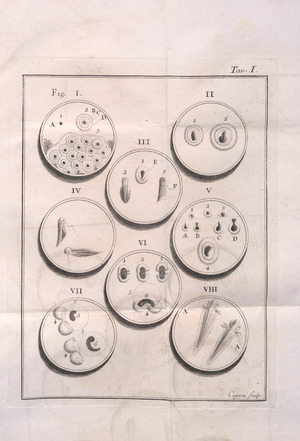Lazzaro Spallanzani facts for kids
Quick facts for kids
Lazzaro Spallanzani
|
|
|---|---|

Lazzaro Spallanzani
|
|
| Born | 12 January 1729 Scandiano, Duchy of Modena and Reggio
|
| Died | 11 February 1799 (aged 70) |
| Nationality | Italian |
| Alma mater | University of Bologna |
| Known for | Digestion Animal fertilisation Discrediting spontaneous generation Animal echolocation |
| Scientific career | |
| Fields | Biology |
| Institutions | University of Modena and Reggio Emilia University of Pavia University of Padua |
Lazzaro Spallanzani (1729–1799) was an Italian priest, biologist, and physiologist. He made many important discoveries through experiments. His work helped us understand how bodies work, how animals reproduce, and how bats use sound to find their way.
His research helped to disprove the idea of spontaneous generation. This was a belief that living things could just appear from non-living matter. While Spallanzani paved the way, Louis Pasteur finally put an end to this idea much later. Spallanzani's main discoveries were written in his book Experiences to Serve to the History of the Generation of Animals and Plants (1786).
Contents
About Lazzaro Spallanzani
Lazzaro Spallanzani was born in Scandiano, Italy. His father was a lawyer who wanted Lazzaro to study law. But young Lazzaro loved spending time with animals and nature.
He first studied law at the University of Bologna. However, he soon changed his mind and decided to study science instead. His cousin, Laura Bassi, was a physics professor there. She greatly influenced his interest in science.
In 1754, when he was 25, Spallanzani became a professor at the University of Reggio. He taught subjects like logic and Greek. Later, in 1763, he moved to the University of Modena. There, he spent all his free time studying natural science.
He received many job offers from other universities. In 1768, he accepted an invitation from Maria Theresa to teach natural history at the University of Pavia. He also became the director of the museum there. He made the museum much better by adding collections from his travels.
In 1785, he was invited to the University of Padua. But to keep him, his university doubled his salary. They also let him travel to Turkey for almost a year. There, he made many observations, including about copper and iron mines.
When he returned home, he was welcomed like a hero. Students from the University of Pavia cheered for him. During this time, some people questioned his honesty about the museum's collections. They accused him of taking specimens for himself.
A legal investigation quickly cleared his name. Spallanzani even played a trick on one of his accusers. He planted a fake animal specimen. When his accuser published it as a new discovery, Spallanzani revealed the joke. This made his accuser look foolish.
In 1796, he was offered a job in Paris, France, but he was too old to move. Lazzaro Spallanzani died in 1799 from bladder cancer. After his death, his bladder was removed for study. It is now on display in a museum in Pavia.
Spallanzani was a great traveler and collector. He was also a brilliant teacher. He was always asking questions about nature. His work showed his fresh and original ideas in many areas of science. He was friends with famous thinkers like Lavoisier and Voltaire.
Scientific Discoveries
Challenging Spontaneous Generation
Spallanzani's first scientific work was in 1765. It was called Essay on microscopic observations regarding the generation system of Messrs. Needham and Buffon. This book was the first to strongly argue against the idea of spontaneous generation.
At that time, many scientists believed that tiny living things could just appear from non-living matter. They thought a "life-generating force" existed in certain materials. Spallanzani did experiments to test this idea.
He showed that if you boiled a material for an hour, the microbes (tiny living things) would die. If the material was then sealed tightly, no new microbes appeared. This suggested that microbes came from the air, not from the material itself.
Another scientist, John Needham, argued that boiling destroyed the "vegetative force" needed for life to appear. But Spallanzani's work helped pave the way for Louis Pasteur. Pasteur later proved that spontaneous generation was not real.
Understanding Digestion
In his book Dissertation on the physiology of animals and vegetables (1780), Spallanzani was the first to explain how digestion works in animals. He proved that digestion is not just about grinding up food.
He showed that it is a chemical process. This process mainly happens in the stomach. It uses special liquids called gastric juice to break down food.
Animal Reproduction
Spallanzani studied how animals reproduce. He wrote about it in his book Experiences to Serve to the History of the Generation of Animals and Plants (1786). He was the first to show that both spermatozoa (sperm) and an ovum (egg) are needed for fertilization.
He was also the first to perform in vitro fertilization (IVF) using frogs. This means he fertilized eggs outside the body. He also did the first artificial insemination using a dog. Spallanzani also found that some animals, like newts, can regrow body parts if they are injured.
Even with his scientific background, Spallanzani believed in an idea called preformationism. This idea suggested that living things develop from tiny, already formed versions of themselves. For example, he thought animals came from tiny animalcules.
He did an experiment where he separated frog sperm into a liquid part and a part with tiny animalcules. He thought the liquid part caused fertilization. He believed that the animal's shape was already in the egg. He thought sperm just activated its growth.
Spallanzani is also famous for his experiments in 1793 on bats. He wanted to know how bats could fly at night without hitting things. He noticed that bats could avoid obstacles even in complete darkness.
He covered the eyes of bats with opaque discs. To his surprise, the bats still flew normally. He even removed the eyeballs of one bat. That bat still flew quickly and safely through dark tunnels.
He concluded that bats do not need their eyes to navigate. He knew they used some other sense. Another scientist, Louis Jurine, found that bats became disoriented when their ears were plugged.
Spallanzani repeated these experiments. He used better earplugs made of wax or other materials. He found that blinded bats could not navigate without hearing. He even did some painful experiments by damaging the bats' ears.
After these tests, he was convinced that hearing was very important for bats to fly normally. He suggested that the ear was an organ for navigation. The exact scientific reason for this, called echolocation, was discovered much later in 1938.
Studying Fossils
Spallanzani also studied fossils. He looked at marine fossils found far from the sea and high in mountains. In 1755, he published a paper about this. He believed that the movement of the sea, not a great flood, caused these fossils to be in the mountains.
He also wrote about his trips to places like Portovenere. He discussed finding fossil shells inside volcanic rocks. He also wrote about human fossils and fossils of animals that no longer exist. His work showed his wide interest in all parts of nature.
Other Discoveries
Spallanzani also made important observations about blood circulation and respiration (breathing). In 1777, he named a group of tiny, tough animals Tardigrada. These animals are known for being able to survive in extreme conditions.
In 1788, he visited volcanoes like Vesuvius and Mount Etna. He wrote about his findings in a large book published four years later.
Many of his collections are now in the Palazzo dei Musei in Reggio Emilia, Italy. They are displayed in two rooms called the Museo Spallanzani.
Honors and Recognition
Spallanzani was elected a Fellow of the Royal Society of London. He was also a member of the Prussian Academy of Sciences, the Royal Swedish Academy of Sciences, and the Göttingen Academy of Sciences and Humanities.
See also
 In Spanish: Lazzaro Spallanzani para niños
In Spanish: Lazzaro Spallanzani para niños
- List of Roman Catholic scientist-clerics
- Charles Jurine




